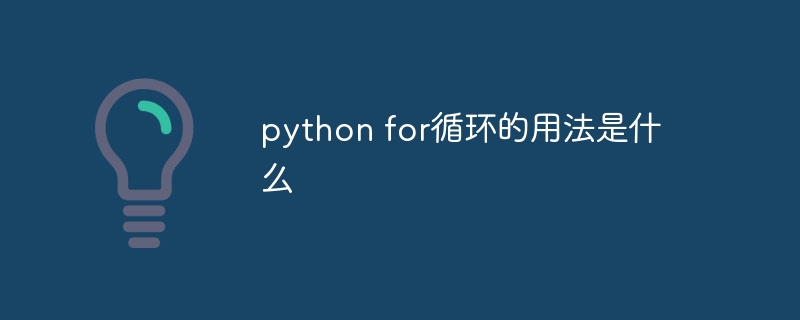 Web Front-end
Web Front-end JS Tutorial
JS Tutorial Issues you should pay attention to when using for loops in javascript - with a summary of the problems_javascript skills
Issues you should pay attention to when using for loops in javascript - with a summary of the problems_javascript skillsUsing a loop is convenient if you want to run the same code over and over again, with different values each time.
Many times we use for loops, and the for loop department often loops over an array. Many times we write it like this:
// 次佳的循环
for (var i = 0; i < myarray.length; i++) {
// 使用myarray[i]做点什么
}
Although there is no big problem with such code, it will get the length of the array every time it loops, which will reduce your code, especially when myarray is not an array, but a HTMLCollectionWhen object.
Look at the code below:
for (var i = 0, max = myarray.length; i < max; i++) {
// 使用myarray[i]做点什么
}
This code will only obtain the length of the array once, which improves the quality of the code;
With the single var form, you can pull the variable out of the loop, like this:
function looper() {
var i = 0,
max,
myarray = [];
// ...
for (i = 0, max = myarray.length; i < max; i++) {
// 使用myarray[i]做点什么
}
}
Summary of problems when JavaScript uses for loop
The discussion of this issue originally came from internal company emails. I just recorded the discussion of this issue.
When locating the problem, some project teams found that when using “for(x in array)”, unexpected values of x appeared in the IE browser.
Specifically, if the Array.prototype.indexOf method is customized (for example, due to a certain prototype pollution), it may be because the old version of IE browser does not support the array.indexOf method, and the developer I really want to use it, but such a browser may cause the following problems:
Array.prototype.indexOf = function(){...};
var arr = [1, 2];
for (x in arr) console.log(x);
//will output
1
2
function(){…}
In other words, the indexOf method is output.
The solution is simple, either don't add this method, or use a loop like "for (i=0; i etc.
But what is the nature of the problem? Some people speculate that it may be because the usage of for(x in obj) is actually to traverse an object, and the implementation of array is actually the same as that of ordinary objects, except that key is Just a given value:
{0:"something", 1:"something else"}
It was also mentioned in a stackoverflow question and answer that there is a difference between using for...in and for(;;) when traversing an array. The former means to enumerate the properties of the object. There are two problems:
The order of enumeration is not guaranteed;
Inherited properties are also enumerated;
In terms of support for Array.prototype.forEach, it can be clearly seen from this table that IE8 and below cannot be accurately supported:

Here is also a detailed explanation of the compatibility of the forEach method. In fact, major JavaScript frameworks (such as jQuery, Underscore, Prototype, etc.) all have safe and general implementations of for-each functionality.
It is also mentioned in the for in chapter of JSLint that the for in statement allows looping through the attribute names of the object, but it will also traverse those attributes inherited through the prototype chain, which in many cases will cause unexpected errors. . There is a crude solution:
for (name in object)
{ if (object.hasOwnProperty(name))
{ .... } }
Some people also mentioned the problem when using for(var i=0;i
Using "let" introduced in JavaScript 1.7 solves this problem, making i a true block-level variable:
for(let i =0; i < a.length; i++)
Finally, Google’s JavaScript style guide also involves this constraint:
for-in loop: Only for iterating over keys in an object/map/hash
The above is the entire content of this article about the issues that should be paid attention to when using for loops in JavaScript - with a summary of the issues. I hope it will be helpful for future work and study. We welcome criticism and suggestions from industry insiders.
 怎么用php实现求100以内的奇数Dec 23, 2022 pm 06:54 PM
怎么用php实现求100以内的奇数Dec 23, 2022 pm 06:54 PM实现步骤:1、使用for语句控制范围来遍历1~100的数字,语法“for ($i = 1; $i <= 100; $i++) {循环体代码}”;2、在循环体中,利用if语句和“%”运算符获取并输出奇数即可,语法“if($i % 2 != 0){echo $i." ";}”。
 PHP中for循环的执行顺序是什么Sep 22, 2021 pm 06:24 PM
PHP中for循环的执行顺序是什么Sep 22, 2021 pm 06:24 PM执行顺序:1、执行“初始化表达式”;2、执行“条件判断表达式”,如果表达式的值为真,则执行“循环体”,否则结束循环;3、执行完循环体后,执行“变量更新表达式”;4、变量更新后,进入下一次循环,直到条件判断值为假,结束循环。
 JS循环学习:for循环语句的使用(示例详解)Aug 03, 2022 pm 06:45 PM
JS循环学习:for循环语句的使用(示例详解)Aug 03, 2022 pm 06:45 PM在之前的文章《JS循环学习:while循环语句的使用(示例详解)》中,我们简单了解了 while 循环和 do while 循环,而今天再来介绍一种循环——for 循环语句,希望对大家有所帮助!
 mysql有for循环吗Mar 30, 2023 pm 08:26 PM
mysql有for循环吗Mar 30, 2023 pm 08:26 PMmysql没有for循环,MySQL是不支持for循环语句的,只支持WHILE、REPEAT和LOOP三种循环语句,MySQL提供循环语句,允许您根据条件重复执行一个SQL代码块。
 如何使用Python中的for循环Oct 25, 2023 pm 12:18 PM
如何使用Python中的for循环Oct 25, 2023 pm 12:18 PM如何使用Python中的for循环Python是一种简单易用的编程语言,其中的for循环是非常常用的工具之一。通过使用for循环,我们可以循环遍历一系列的数据,进行有效的处理和操作,提高代码的效率。下面,我将通过具体的代码示例,介绍如何使用Python中的for循环。基本的for循环语法在Python中,for循环的语法如下:for变量in可迭代对象:
 如何在Go语言中利用for循环实现翻转操作Mar 24, 2024 pm 02:15 PM
如何在Go语言中利用for循环实现翻转操作Mar 24, 2024 pm 02:15 PM标题:Go语言中利用for循环实现翻转操作的方法在Go语言中,通过使用for循环可以很方便地对数组、切片等数据结构进行翻转操作。在本文中,我们将介绍如何利用for循环来实现数组和切片的翻转,并给出具体的代码示例。翻转数组的操作首先,我们来看如何通过for循环实现数组的翻转操作。我们定义一个包含整型元素的数组,并使用for循环将其翻转。packagemain
 如何使用C语言中的for循环将数组中的偶数和奇数分开?Aug 25, 2023 pm 03:09 PM
如何使用C语言中的for循环将数组中的偶数和奇数分开?Aug 25, 2023 pm 03:09 PM数组是一组以单一名称存储的相关数据项。例如intStudent[30];//student是一个数组名,包含单个变量名的30个数据项集合数组的操作搜索-用于查找特定元素是否存在排序-它有助于排列数组中的元素按升序或降序排列。遍历-它按顺序处理数组中的每个元素。插入-它有助于在数组中插入元素。删除-它有助于删除数组中的元素。数组中的元素。在数组中查找偶数的逻辑如下-for(i=0;i<size;i++){ if(a[i]%2==0){
 python for循环的用法是什么Sep 26, 2023 am 10:34 AM
python for循环的用法是什么Sep 26, 2023 am 10:34 AMpython for循环的用法是遍历一个可迭代对象、遍历其他类型的可迭代对象、嵌套循环和循环控制语句。详细介绍:1、遍历一个可迭代对象,变量是在每次迭代中用于存储当前元素的名称,可迭代对象是要遍历的对象;2、遍历其他类型的可迭代对象,在每次迭代中,变量char将依次存储字符串message中的每个字符,并通过print函数打印出来等等。


Hot AI Tools

Undresser.AI Undress
AI-powered app for creating realistic nude photos

AI Clothes Remover
Online AI tool for removing clothes from photos.

Undress AI Tool
Undress images for free

Clothoff.io
AI clothes remover

AI Hentai Generator
Generate AI Hentai for free.

Hot Article

Hot Tools

Dreamweaver Mac version
Visual web development tools

SAP NetWeaver Server Adapter for Eclipse
Integrate Eclipse with SAP NetWeaver application server.

Atom editor mac version download
The most popular open source editor

VSCode Windows 64-bit Download
A free and powerful IDE editor launched by Microsoft

SublimeText3 Chinese version
Chinese version, very easy to use





